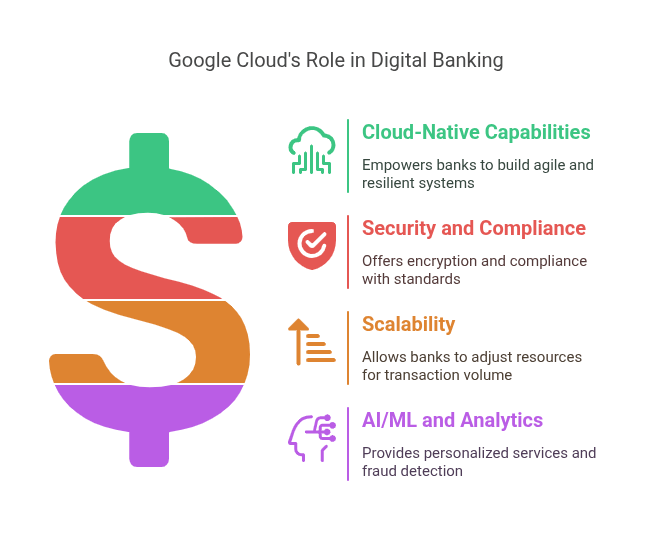

Between 2019 and 2023, the average number of FinTech companies per million people in Southeast Asia increased from 20 to 46. Projections indicate this number may double to 100 by 2027, driven by a burgeoning super-platform economy and favourable regulatory frameworks. The banking industry in Southeast Asia is undergoing a substantial digital transformation, stimulated by new technology and shifting consumer needs. In this blog, we will explore the digital banking landscape in Southeast Asia and how digital banks can leverage Google Cloud to drive innovation, scalability, and security in their banking operations.
Transform Your Digital Banking with GCP
With the rise of digital banks and FinTechs, SEA’s financial landscape will continue to evolve in different dimensions. In addition, Google Cloud acts as a key enabling factor by providing a strong infrastructure and innovative technologies that support modern banking platforms. Financial institutions can now build a digital banking platform on GCP in Southeast Asia to enhance operational efficiency and meet evolving consumer expectations.
The Digital Banking Landscape in Southeast Asia
- Growth of Digital Banks and FinTech Disruptors: The SEA region has experienced significant growth in digital banks. McKinsey reported that there are now more than 40 digital banks operating in Southeast Asia, up from a handful in the 2010s. Most strikingly, more than 10 of them are already profitable.
- Regulatory Landscape and Compliance Challenges: As digital banking continues to develop, regulatory authorities are keeping pace with adjustments to supervise this dynamic sector. Financial institutions must comply with multifaceted requirements for compliance obligations, such as incident management, data protection, and anti-money laundering. Collaboration with technology partners such as Google Cloud could be an effective way for financial institutions to meet their regulatory requirements.
- Customer Expectations: Seamless, Secure, and Always-On Banking: Today’s customers want their banking to be secure and available whenever needed. They expect intuitive interfaces, fast transaction processing, and tailored experiences. This prompts banks to enact digital-first strategies.

Image 1: Google Cloud for Digital Banking
Why Google Cloud for Digital Banking
- Cloud-Native Capabilities for Financial Institutions: Google Cloud provides a wide range of cloud-native services for the financial services industry. These services empower banks to develop an agile, scalable, and resilient architecture that can accommodate changing market needs.
- Security, Compliance, and Data Sovereignty Considerations: Security is a critical consideration for banks. Google Cloud offers substantial security protections, including encryption and sophisticated threat detection systems, with appropriate compliance with local and international standards. Furthermore, banking customers can benefit from data sovereignty services that help banks manage the location of their data.
- Scalability for Increasing Digital Transactions: Cloud infrastructure allows a bank to scale resources as needed in response to fluctuations in transaction volume while preserving performance. The ability to adjust in real-time to reflect transaction volume is key to ensuring a seamless customer experience at peak transaction times.
- AI/ML and Analytics to Provide Personalized Banking Experience: Google Cloud’s AI and machine learning services enable the protection of AI and proactive measures to analyze large amounts of data to provide personalized services, fraud detection, and other actionable insights related to customer behavior.
Modernizing Legacy Banking Systems with Google Cloud
To keep up with the digital era, financial institutions in Southeast Asia need to modernize their legacy banking systems. A lot of traditional banking institutions still operate on a monolithic architecture that is inflexible, expensive, and slow to respond to the market. Moving away from legacy banking architecture to cloud-based, microservices architecture creates flexibility, scalability, and improved operational capacity. Google Cloud assists with this transformation by providing a range of solutions to facilitate migration with minimal downtime.
A significant challenge with modernization is having a legacy information technology infrastructure and introducing new cloud technologies. A hybrid and multi-cloud strategy allows financial institutions to shift workloads to and between clouds without disrupting core operational functions. The hybrid cloud enables banks to host sensitive data on their premises while extending cloud capabilities for advanced analytics, AI fraud detection, and real-time transaction processing. Multi-cloud strategies promote more resilience, reducing dependence on one cloud provider and allowing compliance with local data sovereignty laws.
By embracing cloud-native core banking on Google Cloud, banks can innovate at scale, reduce costs, and deliver customers a superior digital banking experience. This transformation enhances system performance and allows for the faster deployment of new financial products, integration with FinTech ecosystems, and enhanced cybersecurity defences.
Future Trends in Cloud-Native Digital Banking
As digital banking continues to change, several emerging trends are expected to redefine how financial institutions operate, interact with customers, and safeguard security in an increasingly digital-first world. Rapid advancements in artificial intelligence, embedded finance, and cybersecurity mean banks will need to be proactive on these innovations to retain a competitive advantage.
The Rise of Agentic AI in Banking Operations: Agentic AI, which represents a new generation of AI characterized by self-directed decision-making, is a game-changer for the banking sector because it streamlines elaborate processes and increases operational efficiency. In contrast to prior generations of AI that required human supervision, agentic AI is capable of autonomously performing tasks associated with loan approvals, fraud detection, or risk assessments, all based on real-time and continual learning.
Embedded Finance and Banking-as-a-Service (BaaS): Embedded finance is emerging as a major trend, enabling financial services to be embedded into non-financial platforms, including e-commerce websites (like Shopify), ride-sharing apps (like Uber), and digital wallets (like PayPal). Embedded finance is driven by Banking-as-a-Service (BaaS), which allows traditional banks to provide their infrastructure and regulatory environment to FinTechs and other businesses.
For example, a retailer could provide on-the-spot credit or insurance at the point of delegated services or offer services without requiring the customer to take the extra step of visiting a bank. In addition, this enables banks to expand their reach to a broader customer base. While businesses can provide seamless financial services that positively affect customer experience. Google Cloud has an API-driven approach, which allows financial institutions to quickly deploy BaaS solutions and integrate with third-party service providers easily and securely.
Hyper-Personalization with AI and Predictive Analytics: Consumers today want banking experiences that are hyper-personalized to their financial behaviours and preferences. As a result, banks are leveraging AI and predictive analytics to deliver customized financial products, including personalized loan offers, recommended savings options, and personalized credit scoring. Banks can analyze their consumers’ banking data in real-time in new ways by using Google Cloud’s BigQuery and machine learning technologies, which enable them to think ahead about customers’ financial planning, as well as offer automated budgeting tools to help consumers manage their money. This measure of personalization increases customer satisfaction, retention, and engagement.
Case Studies
HDFC ERGO – Sales Super App for Insurance Advisors: Niveus collaborated with HDFC ERGO to develop a scalable sales super app that allowed insurance advisors to hold their policies, renewals, and customer onboarding processes properly. Through the use of GCP, Niveus was able to provide a high-availability, real-time data access solution that improved performance. Providing the insurance advisor with improved customer service and faster sales cycles.
AU Small Finance Bank – API Management with Apigee Hybrid: Niveus used Apigee Hybrid to help AU Small Finance Bank to secure and maintain scalable API management across multiple cloud and on-prem environments. The solution ensured technical compliance while eliminating tedious app integration. Developers worked more efficiently and ensured data compliance all around. This hybrid architecture paradigm not only contributed to driving digital banking innovation through improved operational control but also supported a new world of possibilities for the bank.
Conclusion
In Southeast Asia, the digital banking movement is transforming the financial services landscape, as advancements in technology, regulatory changes, and customer expectations are driving banks and FinTech to scale. This, in turn, leads to a demand for more agile, secure, and innovative solutions.
Financial institutions can benefit from using scalable cloud infrastructure and real-time analytics, leading to enhanced operational efficiency, increased financial inclusion, and more seamless and customer-centric banking experiences.
Google Cloud is the perfect platform for transformation, offering cloud-native functionality and advanced AI/ML tools. It also provides comprehensive security frameworks that enable financial institutions to modernize core banking systems and enhance customer experience.
At Niveus Solutions, we specialize in empowering banks and financial institutions to leverage Google Cloud to develop their next generation of scalable and resilient digital banking platforms. Our deep domain expertise as cloud engineers, cloud architects, cloud security specialists, data and machine learning engineers means we create and deliver unique cloud solutions for banks and financial institutions to digitally transform their offerings.
As banks and financial institutions think about what’s next, agentic AI, embedded finance, and predictive analytics will be important considerations in staying competitive with digitally native banks. By partnering with Niveus Solutions, banks can develop new growth opportunities at scale, strengthen security and compliance, and provide secure, personalized, always-on banking experiences that meet the demands of modern customers.











